|
Marvel has had several attempts to turn its most successful
comic character into an animated serial. However, never before
has the true essence of the student behind the mask been captured
so effectively as in the nineties version. Ty Powers reports...
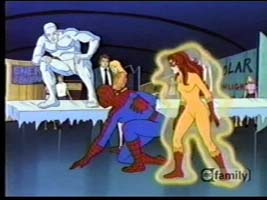 |
The
original series (who remembers "Spider-Man, Spider-Man, does
whatever a spider can ... Can he swing on a thread, take a
look overhead." etc?), first shown on ITV in 1967, was constructed
of individual stories, often involving common criminals, as
opposed to costumed power-crazy or sociopathic villains. Spider-Man
and his Amazing Friends (BBC 1, 1983), although popular,
was generally light-hearted, the protagonist being aided in
his endeavours by Bobby Drake as Iceman and Angelica Jones
as Firestar. Together they annoyingly shouted "Spider Friends
... Go for it!" at every opportunity. This, combined with
the living-room which conveniently transformed into a computer-laden
operations room ... and a nauseatingly cute dog, meant it
obviously wasn't supposed to be taken too seriously. A lesser
known version which ran to only sixteen episodes was Spiderwoman
(ITV, 1983), a team-up between Spider-Man and the new, short-lived
character.
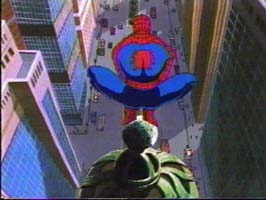 |
Screened
in the UK in the mid-nineties (11:00 on BBC 1 every Saturday,
and twice-weekly on Sky One), there are two main reasons why
this Fox adaptation is so superior to those previous efforts.
The first is the improved conventional animation techniques
combined with computer-generated 3-D imagery. Sequences involving
Spider-Man or a helicopter moving between buildings is extremely
impressive. One such example shows movement, smooth and camera-like
across water towards shore, where the skyscrapers are reflected
on the surface.
Secondly
and more significantly, there is greater storyline continuity
than ever before, which brings the teenage lead's agonies
closer to casual audience understanding. Before elaborating
the importance of this further, a brief background explanation
is called for.
Peter
Parker is an ordinary but scientifically gifted teenager who
is accidentally bitten by a radiation-infected spider during
a university experiment, giving him the proportionate strength
and abilities of an arachnid. Although previously weak and
often oppressed, he cannot display his new-found physique
for fear of inadvertently revealing his secret identity.
What
makes Spider-Man unique (at least at the time of his
creation by Marvel's Stan Lee in 1962) and relatable is that
instead of helping to change his life for the better, as with
the majority of superheroes, the acquisition makes his private
life a miserable existence of missed opportunities. He is
even forced the hard way to channel his abilities to fight
crime - after his failure to intervene in a robbery results
in the death of his Uncle Ben at the hands of the same perpetrator.
Ultimately, he doesn't always make the right decisions, but
his motives are dictated by what he feels is right. To cover
this insecurity and general bad luck is the irrepressible
humour, faithfully carried over from the comic books. In strict
contrast to D.C.'s Batman, who is dark and moody and hardly
says a word, Spider-Man never shuts up. The relentless quips,
rather than becoming tiresome, are a constant amusement for
the viewer - if not the respective villains.
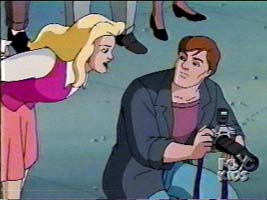 |
The
Peter Parker of this series is nineteen. Whilst beyond his
na´ve bookworm school days when no female would benefit him
with a second glance, he remains partially insecure unsuccessfully
balancing his private life with amateur but effective policing
commitments. Realism dictates that it's impossible to win
every fight; sometimes subterfuge is necessary - or help from
other quarters such as Nick Fury and his S.H.I.E.L.D. organisation,
or in one case Professor Xavier's X-Men.
There's no doubt that Marvel was fully committed to doing
justice to the hard-hitting stories of recent years. All the
favourite reprobates raise their ugly but colourful heads:
Smythe and the Spider Slayers, the Hobgoblin, Venom, the Scorpion,
the Vulture, the Chameleon, Kraven the Hunter and, of course,
Doctor Octopus. In fact the history of these characters means
that twenty-minute stories seldom flesh them out as sufficiently
as they deserve. This setback is partially rectified by having
major storylines running to several episodes.
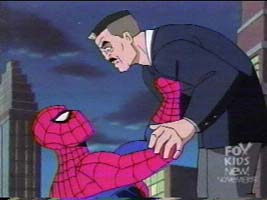 |
The
relating or peripheral characters are believable in that they
highlight real problems. The editor of the Daily Bugle, where
Parker sells pictures of Spider-Man tackling criminals, is
a loudmouthed extrovert who purposely underpays for the headlining
snaps and despises Spider-Man with a passion - even financing
the powers of the Scorpion purely to see the web-slinger publicly
humiliated. But more interesting is the on/off relationship
with Felicia Hardy (later to become the Black Cat) and Mary
Jane Watson (aspiring actress and model). Regularly Parker
is forced to make excuses to get away, and often arrives late
or fails to materialise at all for prearranged dates, driving
his personal relationships further apart.
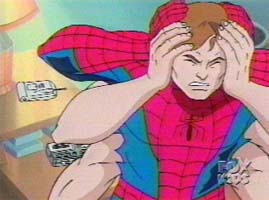 |
Most
of the stories are variations on basic established pieces,
and the science therein is fundamentally contrived. However,
dotted among these are some outstanding tales. The Saga
of the Alien Costume, which ran for seven years in the
comics, is contained in only three parts here and Venom (a
relatively new and enduring villain, compared with Doc. Oc.
and others) is first seen and ultimately dispatched in the
final part of the trilogy. In this instance it makes for a
breakneck-pace rollercoaster ride. The Neogenic Nightmare
saga contains more than a dozen episodes telling the story
of Spider-Man's mutation and his attempts to reverse the process.
At one stage he even sprouts extra arms and then becomes Man
Spider. Of course, along the way we are introduced to other
Marvel characters such as the vigilante the Punisher, Morbius
the vampire, and Blade the vampire hunter. The web-slinger
is periodically aided by Dr. Curt Connors (a.k.a. the Lizard)
and his Neogenic Recombinator machine.
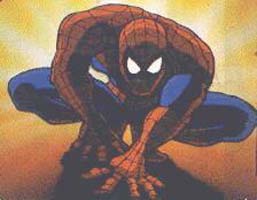 |
In
conclusion then: the scripts are relatively tight; the animation,
whilst not in the league of most Japanese Manga releases (the
overseas Animation House is Tokyo Movie Shinsha), remains
several notches above average - particularly the computer
generated backgrounds; and the action is frantic, sometimes
a little too hectic. I have great respect for this character
from my childhood, and this is certainly the best screen adaptation
of the myth thus far (I won't mention the seventies live action
series - oops, I just did!). It certainly helped fill the
gap before the arrival of the long-awaited live action movie.
Selective
stories are available on video. In particular, look out for
The Venom Saga (now also on DVD), which is both fast
and funny, and includes a short documentary with Stan Lee
talking about the origin of Spidey in the comics.
Return
to...

|